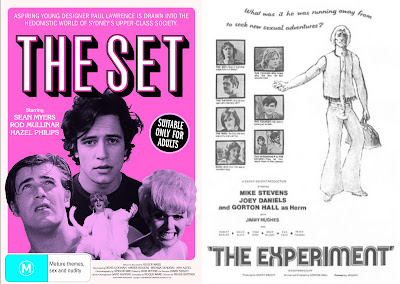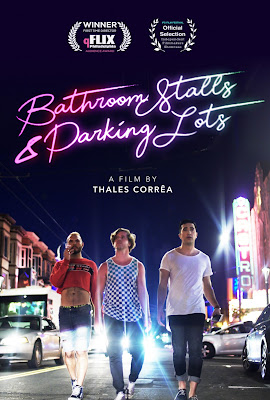What makes journeys of self-discovery exciting—and scary—is the unknown. You’re travelling to an undefined destination with only a vague idea of what direction you’re headed. If you’re secure enough to know where you’re going and how to get there, then there’s no need to start the journey—you’ve discovered your “self” already.
But often self-discovery doesn’t start as a journey; it’s more like a prison escape. Escape is foremost in the mind of Paul (Sean Myers, billed as Sean McEuan) when he leaves the dreary seaside town where he lives with his miserable parents for the swinging life of 1969 Sydney in the 1970 Australian movie THE SET.
The catalyst for Paul’s departure is not, surprisingly, his crater-faced father insisting Paul take a job at the shipyards rather than waste his time at some candy-ass college. No, it’s after some beach ballin’ with his girlfriend Cara (Amber Rodgers, billed as Julie Rodgers), when she reveals that while in boarding school, she had an affair with—OMG!—a girl. This admission so horrifies Paul that he runs away, bare-assed naked, lest he get any more of Cara’s Sapphic cooties on him.
 |
Paul doesn’t stay mad at Cara for long. Also, this scene is
allegedly taking place at night (during May in Fairbanks,
Alaska, apparently.) |
Paul then moves to Sydney. While on break from his department store job, he admires the window display of a downtown antiques store. On the other side of the glass Paul is admired by the store’s owner, renowned designer Marie Rosefield (Brenda Senders). Marie’s visiting GBF, Theo (Tracey Lee), is also intrigued by the young handsome window shopper, but politely waits his turn, letting Marie call dibs. Marie, encouraged that Paul is familiar with her work, happily takes the cute bumpkin under her wing, hoping he’ll eventually work his way under her skirt. She even goes so far as to recommend him as an assistant to the famous artist Mark Bronski (Denis Doonan, whose Van Dyke, despite all appearances, is not made of felt). All Paul has to do is make a good impression when he meets Bronski at a party, something Paul immediately jeopardizes by downing two drinks in rapid succession. I’ll admit I had trouble staying focused on the drama of this scene as I was too distracted by the Lhasa Apso sitting on Marie’s head.
 |
The Set didn’t win any awards, but Brenda Senders’ hair
deserved Best in Show.
|
Though Paul’s drinking too much and too quickly, it’s Marie who gets drunk, and Marie’s a bitter drunk. After watching Paul cut a rug with a much younger woman wearing a halter jumpsuit similar to Marie’s, Marie demands Paul go home with her and repay her years of kindness (though viewers will swear only a few months have passed) by allowing use of his young, firm body. Paul’s response is less than kind, telling Marie that people thought she was his mother. Before rejoining the party, he tells her: “Your eyelash has come unstuck. Looks a bit revolting. Better fix it, eh?”
Meow!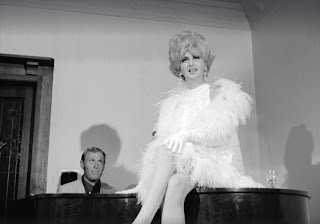 |
| RuPaul’s Drag Race: Bike Lane Edition. |
Marie, devastated by her protégé’s rejection, promptly leaves, only to get killed in a car accident. “Poor bitch. She was in no state for driving,” says Theo when he relays the news to Paul. With the “poor bitch” out of the way, the path is now clear for Theo to make his play for Paul, and rest assured Theo wastes little time doing so. He takes the aspiring designer to a party, and though its populated by men of a distinct persuasion, Paul is oblivious to it being a gay soiree. He only gets a clue when he discovers the truth about the party’s sole female attendee: “Oh god! You’re
a man!” Paul quickly flees the scene but not the party. When he returns moments later, the drag queen warns him: “Watch out, Red Riding Hood, the wolf is after your basket.”
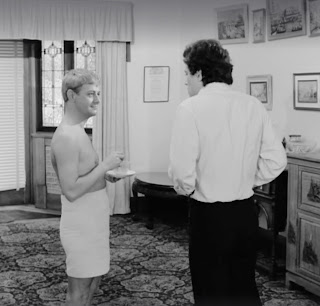 |
| Paul’s walk of shame is made more shameful. |
In the next scene Paul awakens alone in a strange bed. Though it’s implied he was roofied, the expression on his face when he looks in a mirror confirms he was well aware of what went on in that bed. Ashamed, he tries to sneak away, only to be confronted by Theo, wearing nothing but a towel. “Aren’t you even staying for breakfast?” he grins as Paul makes a run for it.
The movie takes its title from Paul’s primary job assignment from Mark Bronski: to design a set for a musical production. Though Paul is praised for having creative vision, he lacks the technical skill necessary to complete the job. Then he’s visited by his sexually frustrated aunt Peggy (TV presenter and comedienne Hazel Phillips in her film debut), his teen-aged cousin Kim (Bronwyn Barber) and Kim’s hot-for-1969 boyfriend Tony (Rod Mullinar, who went on to star in Breaker Morant and Dead Calm), who is studying engineering. Paul’s solution to his dilemma is to recruit Tony for collaboration on the set design. There’s just one hiccup: Tony is an asshole. He first scoffs at the suggestion, then reconsiders when Paul’s girlfriend Leigh, (Ann Aczel, the weakest actor of the bunch), whose hair could house a family of six in Whoville, drops in for a visit. Tony says he’ll help Paul on the condition he gets to move in with him, and Leigh moves in, too. Paul readily agrees, and so does Leigh, happily prostituting herself for the sake of her boyfriend’s career.
Alas, while Paul looks good, he’s a lousy lay. Like, really, really bad. “I am just feeling so damned let down and so frustrated that I could just kill you!” rages Leigh before storming out of the bedroom and the movie, never to be heard from again. Later, Aunt Peggy drops by and, finding Tony alone and not averse to sex with older women, decides to have what her daughter’s having, only to discover Kim’s likely never been served. “Oh, I just can’t win. A husband who’s lost all interest and a boy who wouldn’t know how,” she muses after Tony “leaves [her] in mid-air.” But unbeknownst to Peggy, Kim is being delivered by a plot contrivance taxi, and it drops her at the apartment just in time to discover her mother’s and her boyfriend’s betrayal.
 |
Reflections of a failed fuck.
|
Tired of all these demanding bitches wanting attentive lovers, orgasms and faithful boyfriends, Tony turns his attention to Paul, who, despite having had two girlfriends and a gay one-night stand, is supposed to be too inexperienced to know better. Though Paul was disgusted with himself for having fucked Theo, he’s delighted to be used as Tony’s sentient Fleshjack, and fancies himself in love with the prick Tony rather than just loving Tony’s prick.
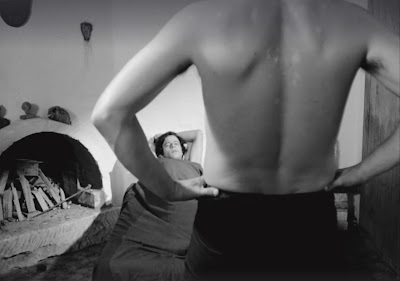 |
Tony decides he and Paul should be roommates with benefits.
|
The department store where Paul is still employed, apparently, learns of his work with Bronski, and decides to make him the host of a radio show about interior design that they sponsor. But Paul quickly reveals himself to be out of his depth, making things worse for himself by adopting the radio persona of a pretentious old queen, for reasons never explained. The show is quickly scrapped, and Paul fired. On the same day Paul’s canned, Tony announces he’s leaving him for a girl (“Good grief, she’s a prostitute!” Paul exclaims upon seeing her straddled on the back of Tony’s motorcycle). After an extended sequence showcasing the many anguished faces of Sean Myers, Paul takes a fistful of pills. Tony, his new relationship barely lasting until nightfall, returns and discovers Paul on the floor unconscious. “The woman’s way, right to the end,” he scoffs.
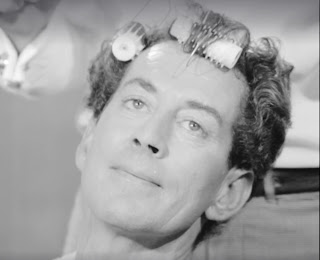 |
John L. gets dolled up to meet his latest
conquest collaborator.
|
It’s Bronski, delivered by the movie’s other car service, Deus Ex Uber, who actually calls for help. Bronski’s reason for showing up all of a sudden is to tell Paul about how his work—so far unseen by the audience—has attracted the attention of London producer John L. Fredericks, who wants Paul to design something for one of his upcoming shows.
Paul survives, recovering in time to design something—with Tony’s help—for the famed producer. Then Paul finally meets “John L.” (Michael Charnley, flaming so hard it’s a wonder he doesn’t spontaneously combust), who makes it clear he plans to give Paul a #MeToo story to share 50 years down the road. But the producer’s plans are thwarted when Paul recognizes John L.’s “cold hard fish” secretary, and suddenly realizes he’s not queer, after all.
More an Aussie Curiosity than a Camp Classic
The Set is based on a then-unpublished novel by character actor Roger Ward (Janus Publishing ultimately published the book in 2011.) In an interview with FilmInk, Ward said every publisher he showed the manuscript to rejected it “not because I was an actor attempting to be a writer, but because I was a writer peddling filth.” Then a fellow actor got the manuscript in the hands of director Frank Brittain, who wanted to adapt the book into a movie. But there was a catch: “Frank told me I had to lift every homosexual narrative from the novel and write a screenplay on that.” Certainly not the note I would’ve expected, especially in the 1960s.
Ward’s assessment of the final product is it’s “a shit film,” which I think is a little too harsh. The Set isn’t good, but it’s not shit, either. A B-grade melodrama that mixes 1960s kitsch with grindhouse sleaze (its subject matter and nudity earned it an “adults only” label in its day, but it’s now rated PG-13), The Set seemed the type of movie I’d fall in love with at first viewing. But as much as I enjoyed the movie for its campy excess, its story is uninvolving. The script, co-written by director Brittain’s wife Diane, is more concerned with plot points than character development, so people’s actions come off as contrivances rather than rooted in character motivations. And for all that happens, the movie has almost as many moments of characters just standing there, silently, waiting for another character to finish packing his bags or another to begin her tirade. Did the editor not realize these parts were supposed to be cut out? Also, set design, at least as presented in The Set, isn’t the most gripping narrative driver. The model of Tony and Paul’s design, when we finally see it, looks like a creation from one of those At Your Fingertips educational shorts from the 1970s that are a staple of the RiffTrax catalog.
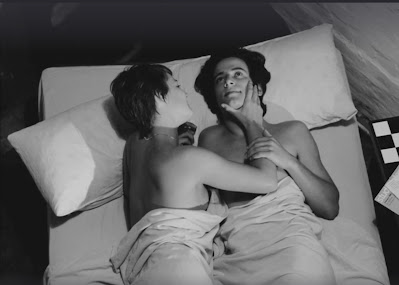 |
Cara and Paul end up right where straight audiences demand.
|
As for its treatment of queer characters,
The Set isn’t totally insensitive, so I guess that makes it progressive for its time. Hell, considering how things are going in the United States, it’s progressive in
our time. Homosexuals are presented as stereotypes, but they aren’t entirely vilified, and there’s some ahead-of-its-time acknowledgment of the fluidity of human sexuality. Still, Paul ending up in a hetero relationship by the movie’s end feels like a cop out.
A Sensitive Coming Out Story or Hardcore Twink Action?
“I’ll never forget that summer—that restless summer, when I found out who I was, and that long walk to tell my father what I learned.” So recalls Billy Joe at the beginning of THE EXPERIMENT, setting the tone for this 1973 coming out drama. And for the first 20 minutes, watching Billy Joe (Mike Stevens, in his only film role) and his best friend Gary Lee (Joey Daniels) roughhouse in the desert, cool off in the swimming pool of what they think is a vacant house, and drink beer stolen from the fridge of the diner owned by Billy Joe’s dad, you might think this is a regular queer indie movie.
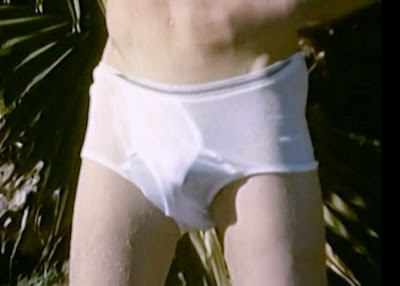 |
| Though there are hints of what’s to come. |
Then the dick sucking starts. Yup, it’s a porno! Billy Joe and Gary Lee giving same sex scrompin’ a try is the titular experiment (“Oh, Gary, it feels weird.”) The teens—at least we’re not meant to believe they’re older than 18—are awkward at first, but quickly get into it, taking turns blowing each other and even getting into a sixty-nine. The sex acts aren’t all that varied, which makes perfect sense. I always find it funny when present-day porn scenes attempt a similar scenario, where one, or both—or all three—guys are supposed to be inexperienced/straight, then end up deep throating like pros and getting DP’d with ease. I’m not saying it isn’t hot, it’s just not believable.
 |
Billy Joe works up his nerve while Gary Lee lies back and waits.
|
Anyway, back to Bill Joe and Gary Lee, who get off with some frottage. Alas, shame comes shortly after they do. The next morning Billy Joe wants to keep “experimenting,” but Gary Lee pushes him away. Just like Paul in The Set, Billy Joe flees—not just the shed in which he and Gary Lee sucked each other off, but the small southwest town where he lives, hitting the road for Los Angeles.
 |
Jimmy Hughes prepares for his scene.
|
Of course, Billy Joe’s literal journey is also a journey of self-discovery. His first encounter along the way is “the salesman” Jimmy Hughes, not only rocking a head of shoulder-length hair but an impressive set of mutton chops as well. In a motel room that makes Motel 6 look like a Four Seasons resort, Billy Joe strips while his older trick, still dressed, takes sips from a pint of whiskey. The nervous teen lays down on the bed while his trick (or john; this encounter might be transactional) looks him over approvingly, then starts to undress.
Billy Joe might be nervous, yet he’s intrigued, too, and so will you once Hughes gets naked. His ‘70s hair may not be for every taste, but his muscular physique has timeless appeal (too bad he’s a convicted rapist). Yet, the salesman’s hot bod isn’t enough to silence Billy Joe’s self-loathing inner dialog: “Goddamn you, Gary. Goddamn you for making me see what I really am.” Then, as so often happens, Billy Joe gets too horny to give a shit about his conflicted feelings, going from lying there like a cadaver to writhing like a voracious cock gobbler.
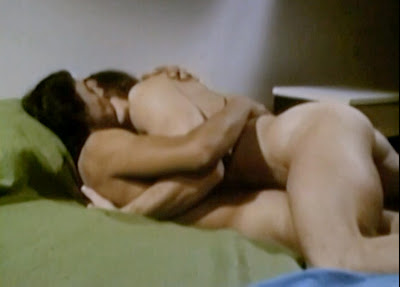 |
Self-loathing cured.
|
All good things must come to an end, and in the morning Billy Joe and the salesman go their separate ways. He hitches a ride from a dark-haired twink in a Mustang, David Craig. Craig makes a play for Billy Joe’s dick, but Billy Joe ain’t having it.
 |
It might have something to do with David Craig’s Grinch-like
smile. (I hadn’t anticipated that this post’s movies would
each merit a Dr. Seuss reference, but there you go.) |
Undaunted, Craig picks up another hitchhiker, Tony Ross, who is much more accommodating. Ross is a lanky guy with a majestic penis. He also looks he could be
Warren Oates’ little brother, which might be why the camera seldom moves above his waist. Not helping is neither Craig nor Ross are particularly dynamic sexual performers, with Craig either tentatively licking Ross’s dick or playing dead while Ross mechanically pumps his ass. Billy Joe, who is napping in the car for the duration of this scene, isn’t missing anything (except a gander at Ross’ dick, which, I repeat, is quite magnificent).
 |
Better call (Gorton) Hall.
|
But Billy Joe’s dad, Herm (Gorton Hall, also the movie’s writer and director), is missing Billy Joe, and so is Gary Lee, who checks out their usual haunts—the desert, the creek—looking for his best friend. He gets sidetracked when he’s cruised by a young guy from Hollywood, slumming in the boonies. Gary Lee takes him back to the shed where he practices his sword swallowing. The encounter isn’t as fulfilling as his night with Billy Joe, however. “Well, I guess is doesn’t matter, as long as you get your nut off,” smirks the Hollywood dude before telling Gary Lee
ciao.
Billy Joe has found a Hollywood dude of his own, and it’s from his home that Billy Joe calls his father. He assures his dad he’s OK; there are just some things he needs to figure out on his own (a touching scene, actually). Billy Joe’s Hollywood dude is the skinny son of a film director who looks like a cross between Jason Gould (a.k.a. Barbra’s son) and Jane Adams. Billy Joe is visibly creeped out by him, but the director’s son persuades him to stay. “I thought there were some things you had to find out about yourself. I can think of no better place than in my basement. Call it the acid test.”
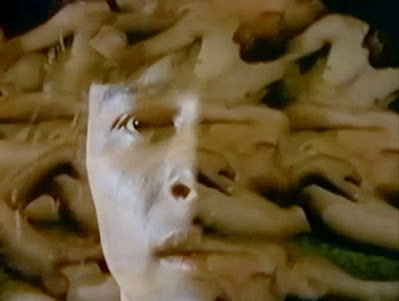 |
| Presenting “the acid test.” |
This time Billy Joe joins in, though most of the action involves his host, as well as Craig and Ross, who are a bit more spirited this time out, though it could just be the kaleidoscope camera tricks making it appear that way. The next morning Billy Joe wakes up on a bed covered in sheets from Bed, Bath &
Fuck You!, with the director’s son advising him to go back to where he came from. “Depravity isn’t something you learn all at once. It takes time and practice.”
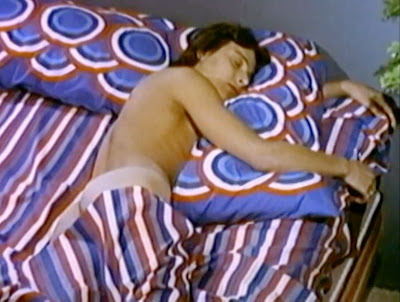 |
From the Peter Max Nightmare Bedding Collection...
|
Billy Joe takes his host’s advice and returns home, where he tells his father that he’s gay. Herm’s response is not what Billy Joe—or audiences in 1973—expects.
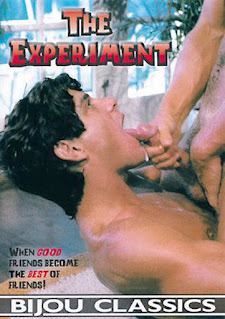 |
The Experiment is available
through Bijou Classics, and
presumably so is the movie from
which they grabbed that cover image. |
According to the
Ask Any Buddy podcast, Gorton Hall was the head chef of the ABC Studio commissary, but he had a number of creative side gigs, including writing pulp novels under his real name (unfortunately the AAB hosts don’t divulge what that real name is; I’d be combing eBay for one of those novels right now if they had), before getting into film via
Pat Rocco. He was also a trained actor, which is why he liked to give himself roles in his films, and he gives one of the more polished performances in
The Experiment. His acting background was also why he liked to rehearse lines with his cast prior to shooting. Hall certainly got better-than-expected performances from Stevens and Daniels (other performers, like the guy cast as the director’s son, are lost causes).
The Experiment was released by Jaguar Films, the same studio that released The Light from the Second Story Window. Like Second Story Window, The Experiment attempts to mimic mainstream Hollywood product and explore the struggles of being gay, as well as prominently feature Joey Daniels. Unlike Second Story Window, however, The Experiment succeeds by keeping its story simple, its scope small. It knows it can’t be a Douglas Sirk melodrama and doesn’t bother trying (though bless Second Story Window writer/director/star David Allen for going for it, budget and talent limitations be damned), Furthermore, The Experiment actually remembers it’s a porn film (though Hall reportedly preferred writing the scripts to directing the movies). It even has a few scenes that are borderline erotic. That said, the movie works better as a coming-of-age/coming out drama, so maybe don’t watch this one if you’re hoping to rub one out.
 |
Billy Joe and Gary Lee try to decide if they are friends
or fuck buddies.
|





